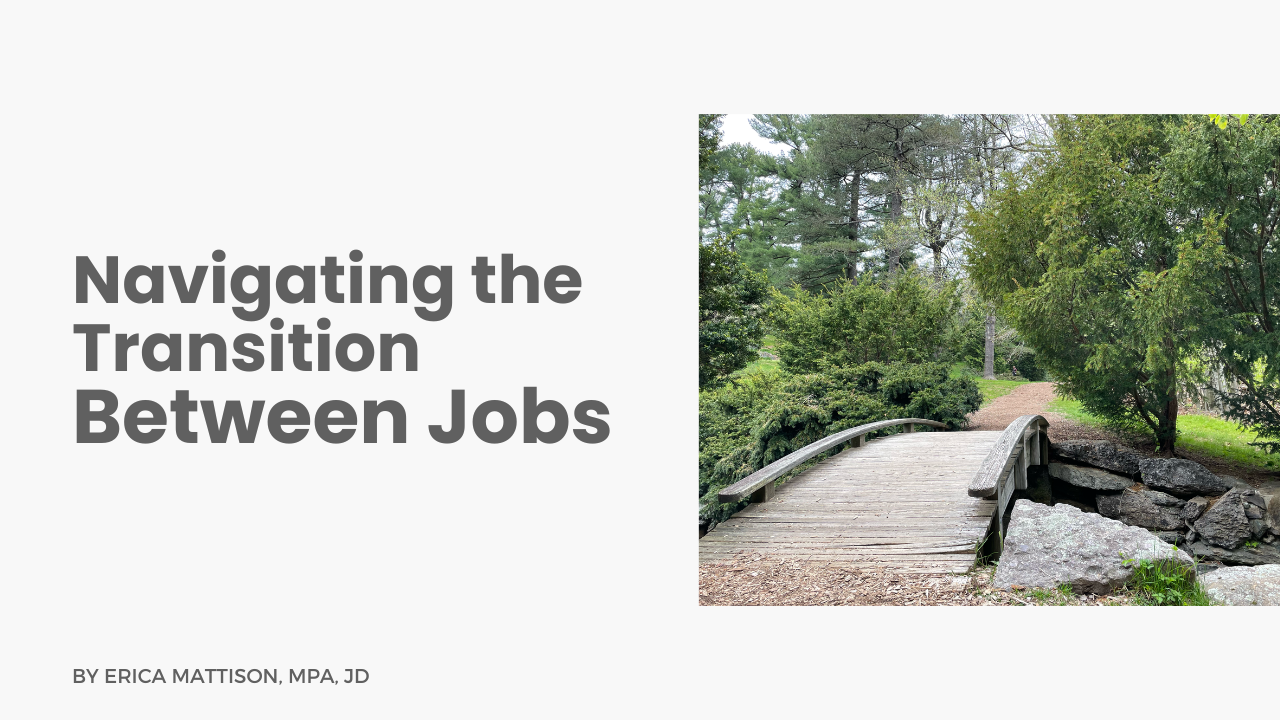How to Navigate the Transition Between Jobs
Nov 24, 2025
A grounded blog post for purpose-driven professionals moving from one chapter to the next
Career transitions rarely feel linear. Whether you are closing out a role, preparing to start a new one, or stepping into a new position after a period of change, this stage can feel like standing on a bridge. One foot rests on what you are leaving behind and the other reaches toward what is ahead.
As a public interest lawyer turned executive coach, I have navigated many career transitions myself and have coached hundreds of purpose-driven professionals through them. One theme is consistent. This transition period carries more influence over your future success and wellbeing than most people expect, and it benefits from thoughtful attention.
If you have not seen my blog post on ending a role thoughtfully, you can read it here ➔
This post focuses on how to move through the transition between jobs with clarity, steadiness, and a sense of capacity that supports both your personal and professional life.
Why this stage feels complicated
Search trends show that during job transitions, people often ask:
-
How do I manage a job change without burning out
-
How do I prepare for a new role while I am still wrapping up the last one
-
How do I stay organized during a career change
-
How do I establish healthy practices before starting my new role
These questions surface because transition periods pull your attention in multiple directions. You may be finishing responsibilities, preparing for something new, or still exploring longer-term possibilities. At the same time, your personal commitments continue.
This mix is natural, and you can navigate it in a grounded and intentional way.
1. Build a clear transition roadmap
One of the most helpful first steps is to map the core areas of your life during this period. These might include:
-
Wrapping up previous work
-
Preparing for the new role
-
Continuing to explore future opportunities, if that applies
-
Supporting family commitments
-
Maintaining routines that help you stay centered
Seeing everything in one place helps you move from feeling stretched to feeling organized and supported.
2. Identify your non-negotiables
Transitions require energy, so it helps to be thoughtful about what gets your attention first. A useful way to do this is through the classic “rocks, pebbles, sand” metaphor.
Imagine you have an empty jar. If you start by filling it with sand, there will not be room for the larger rocks. But if you place the rocks in first, then pour in pebbles, and save the sand for last, everything fits. The same principle applies to your time and capacity during a transition.
Your “rocks” are the commitments that need to remain steady, such as:
-
Rest and sleep
-
Family or caregiving routines
-
A wellness practice
-
Key preparation tasks for your next role
Your “pebbles” are important but more flexible. Everything else is “sand,” which only fits after you have protected your most essential priorities.
This structure helps you avoid overcommitting and gives you the space you need to move through the transition with steadiness.
3. Prepare for your new role before day one
There is a lot you can clarify ahead of time to support a strong start. Focus on:
-
Understanding expectations, rhythms, and communication norms
-
Planning questions for your supervisor
-
Mapping a realistic weekly schedule
-
Reflecting on how you work best and how to communicate that respectfully
-
Identifying where you will need support, feedback, or guidance
This work helps you begin your new role centered and ready, not rushed.
4. Integrate real life into the plan
Career transitions unfold alongside the rest of your life. They do not replace personal commitments.
Take time to assess:
-
What routines help you feel grounded
-
What needs to remain consistent
-
What can temporarily flex
-
Where boundaries are needed to protect your energy
A transition plan is far more effective when it reflects your whole life, not only your professional responsibilities.
5. Plan around key milestones
Every transition has fixed points like last days, start dates, onboarding meetings, periods of rest, or interviews.
Working backward from these dates helps you:
-
Reduce pressure
-
Prepare ahead of time
-
Avoid last minute scrambling
-
Create breathing room that supports your wellbeing
This approach steadies the bridge beneath your feet as you move forward.
Reflection questions
As you move through your transition, ask yourself:
-
What commitments or routines feel essential for me to protect right now
-
Where do I need more clarity, structure, or support so I can move forward with confidence
You do not have to move through this transition feeling overwhelmed. With the right structure and support, you can navigate it with clarity and purpose.
Read the next blog post in this series for guidance on how to start off strong in your new role.

